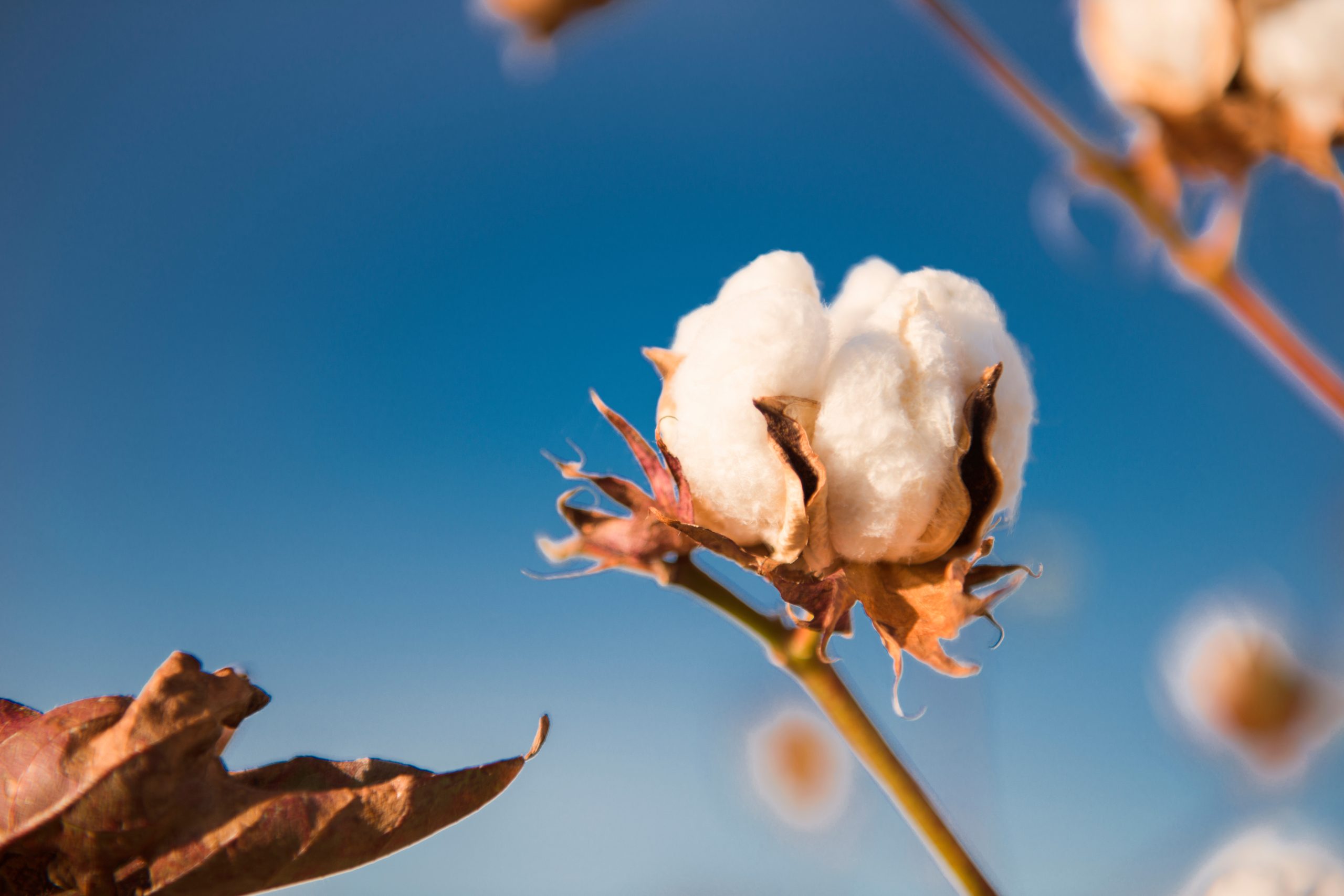Introduction
Cotton accounts for approximately half of all textile products globally. However, flows in the cotton value chain remain opaque, particularly regarding water use, despite various sustainability-related accreditation schemes. Cotton Conscience is an exploratory project, funded by the European Space Agency Business Applications and Space Solutions programme (ESA BASS). It aims to create a multi-layered, space-based approach using SatEO, geotagging and DNA tagging, to track and verify water-wise use in the cotton supply chain from field to garment. This research underpins interest in sustainable cotton sourcing, water stewardship and traceability across the global textile supply chain. Steps from field to gins (devices that separate cotton fibres from their seed), and then from gins to mills, are a key focus, as they are currently obscure and often misrepresented in claimed sustainability footprints. Together, these technologies offer a pathway toward a transparent, water-wise cotton industry, and the enforcement of accountability for water stewardship across complex, globalised cotton value chains. Water stewardship matters; the way we manage, value, and protect water today directly impacts the resilience of our communities, industries and ecosystems.
Transition in the cotton industry
Public concern about the well-documented environmental harms and sustainability challenges associated with the cotton supply chain is increasing pressure on brands and retailers. Novel governance is emerging, driving a transition in the cotton industry towards more responsible cotton production systems and demonstration of the provenance of cotton-containing products.
Water stewardship, commonly unqualified or poorly addressed by regulations, has emerged as a priority. Various accreditation schemes in the cotton supply chain are summarised in Box 1.
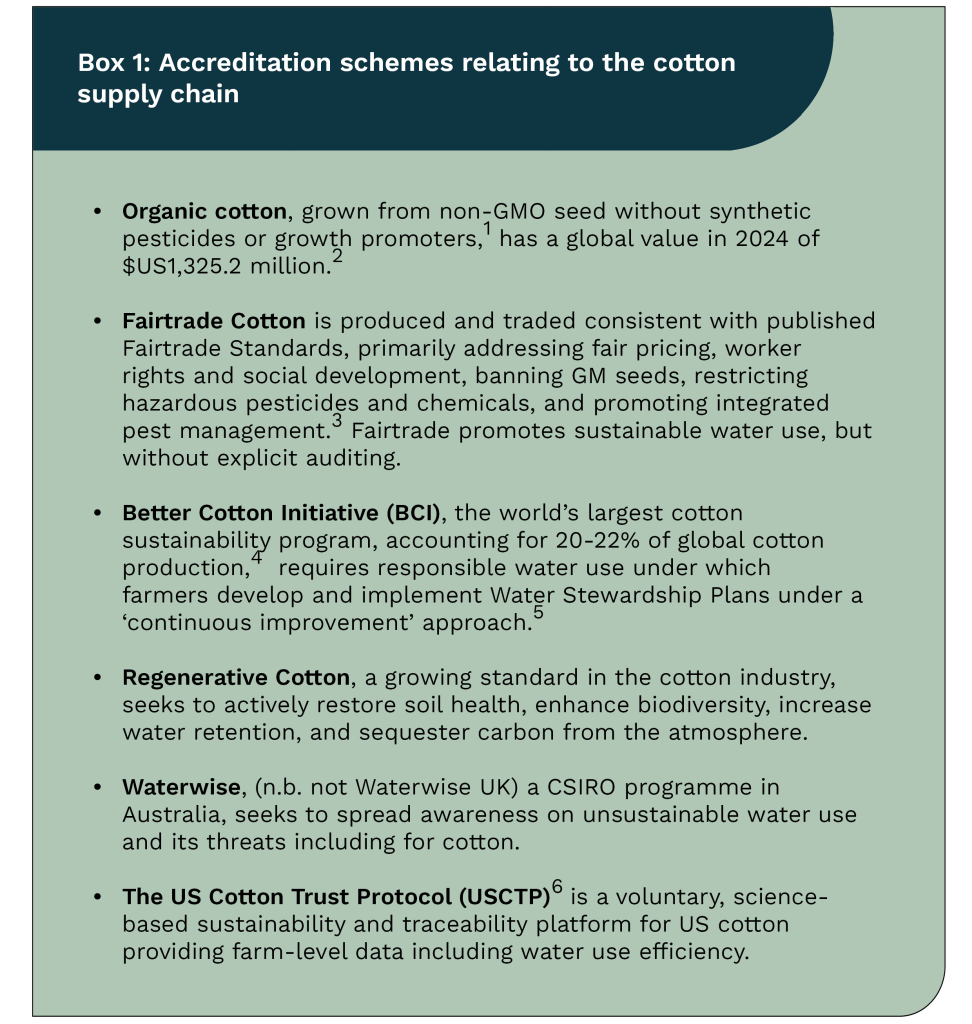
A focus on water in cotton production
Cotton Conscience focuses on the critical role of water in the cultivation of cotton plants, which require substantial inputs during their growing cycle. These inputs influence yield and fibre quality. Cotton Conscience aims to help producers recognise the benefits and opportunities of water-sensitive farming, providing greater integrity throughout the whole cotton value chain and confidence to brands and retailers that their products meet reported sustainability claims. Cotton Conscience will support the delivery of overall environmental benefits, including enhancing water security, and demonstrate the values of SatEO, geotagging and DNA tagging technologies.
Water use in cotton production is significant; whilst the cotton value chain supports the livelihoods of approximately 250 million people, with as many as 1 billion people supported by the wider value chain,7 it can also conflict with other water requirements. China is the largest producer, supplying 25% of global supply at c.30 million bales.8 Bale size varies by producing region, but a common global standard US bale is approximately 218–227 kg. India has the largest cotton acreage, accounting for c.40% of global cultivated cotton area and producing 20% of supply, and the US supplies 12%.9 Production for conventional cotton had an estimated value of $US43 billion in 2024.10,3
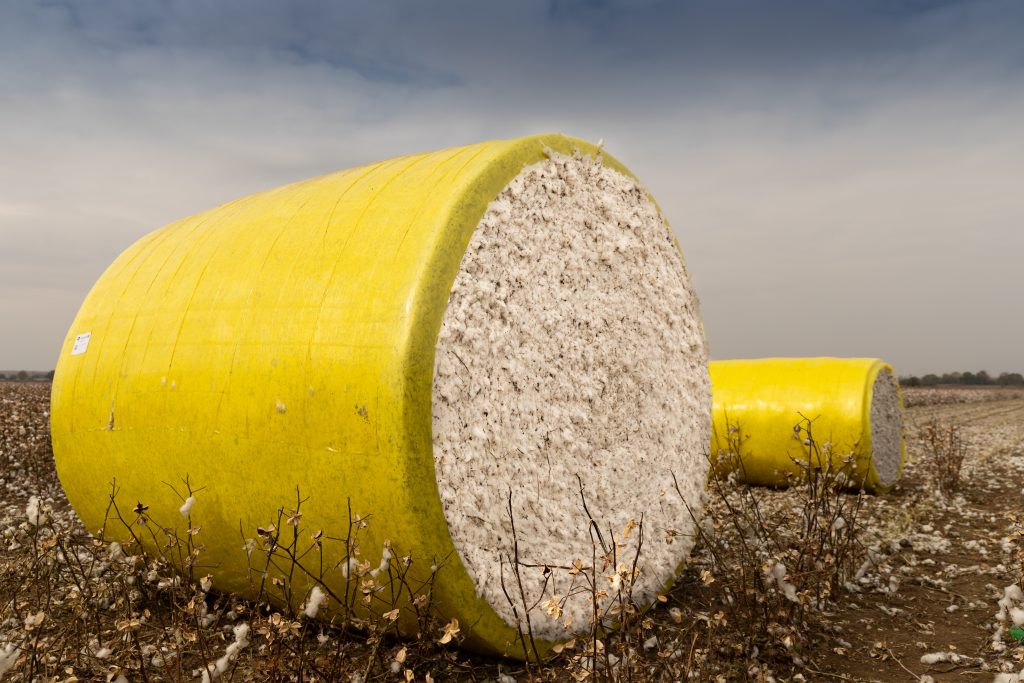
Some cotton is grown in rainwater-fed production systems (green water), but much of global supply derives from irrigation abstracted from surface water or groundwater (blue water), particularly in the drier tropical countries from which most raw cotton derives. Water consumption throughout the cotton value chain is significant; dyeing and finishing alone account for most freshwater withdrawals in apparel manufacturing,11 including water necessary to dilute effluent to acceptable concentrations (grey water). Water consumption at the cultivation stage is the least quantitatively verified step in the value chain. Competition for scarce water is significant. Nearly 2.4 billion people live in water-stressed countries, agriculture accounts for c.70% of global freshwater withdrawals, and climate change intensifies shortages.12
Unsustainable exploitation of water resources in cotton production is widespread, with water consumption in all large cotton-producing countries – including India, China, Pakistan, Turkey and Egypt – recognised as unsustainable.13 The Aral Sea provides an extreme example (Box 2).

The cotton cultivation chain flows from land preparation, to seed planting, through to crop growth generally entailing irrigation, flowering, and harvesting of seed fibres from bolls. Cotton harvested from multiple sources is generally aggregated for ginning. Cotton fibre post-ginning is then graded and stored before being dyed, spun, converted into fabric, and then turned into finished garments. Although many elements of this value chain have been assessed, generalisations are frequently made about water inputs to cotton production. Mixing of bales from different producers can undermine claims of organic, Fairtrade, conditions free from forced labour, or other sustainability-related classifications, without forensic testing. The final textile generally amalgamates cotton types grown to different standards in different parts of the world.15
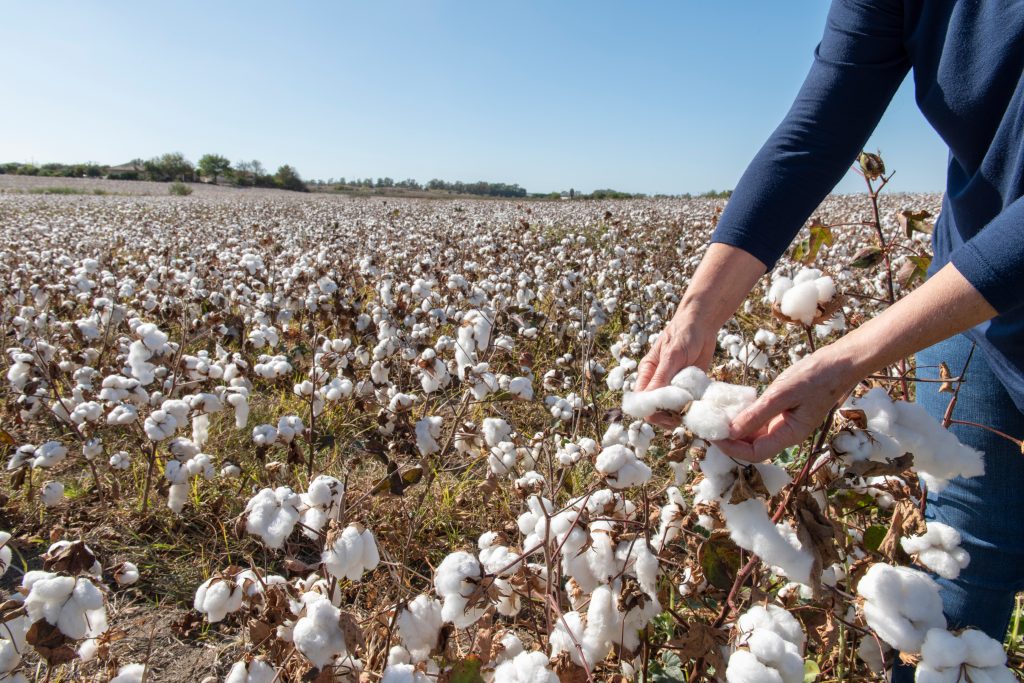
Mass balance approaches, addressing overall proportions of inputs to values chains, can be relevant for blended value chains such as renewable energy in public supply, water from mixed sources, and bio-attributed chemicals. However, retail customers expect that claimed ‘sustainable cotton’ products physically contain cotton from responsible sources, with water inputs a key component. For this reason, tracing cotton from field level through to final product is essential.
Current accreditation schemes, if they assess responsible water use, tend to run from aggregated cotton at the ginning stage. Aggregation of bales, cross-border processing and reliance on paper-based certification often further obscure the origins of cotton and its environmental footprint. Supply chain opacity enables widespread fraud; for example, it has been discovered that BCI-certified cotton from Brazil was linked to illegal land clearing and deforestation.16 The Cotton Conscience project therefore specifically focuses on stages from field to gin and gin to mill.
Water-saving methods in cotton production
A range of management practices contribute to water efficiency and alleviation of water stress – see Box 3:17-21
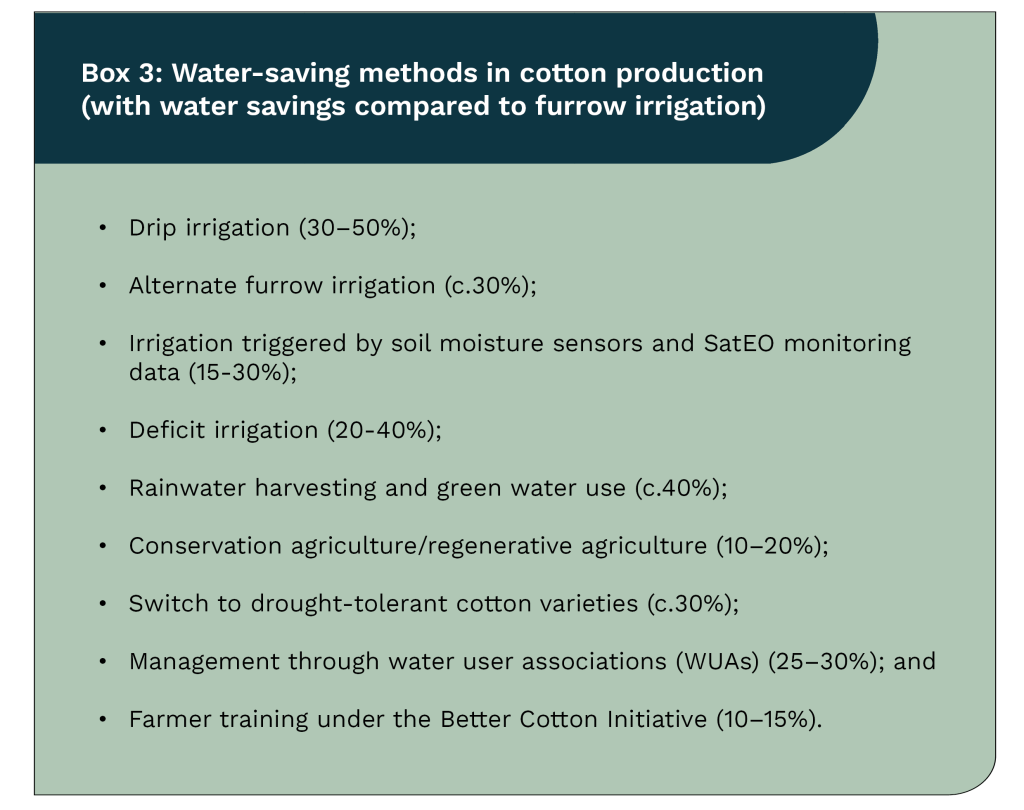
Farmers in the US have access to modern technologies, and allocated water resources often supported large-scale farming systems. Cotton producers in less developed nations, however, tend to grow cotton in small fields or estates with less access to advanced technologies and methods, and frequently need to compete for water with other users. Where these farmers are charged for water use, the true societal values of water are generally not reflected in price.
Tool development to address the field-to-gin gap
Cotton Conscience uses SatEO high-resolution data and technologies to understand cotton growth at the point of production. Data from Sentinel satellites forms the basis of repeatable methods to assess water application to cotton and to gain insights into water use and irrigation efficiency. The research will look at verification of water harvesting and other water-saving techniques contributing to the growth of healthy crops in water-stressed regions. A combination of these sources helps identify where cotton is grown with responsible water use, or where it derives from excessive and potentially illegal water withdrawals. To increase sensitivity, Cotton Conscience is investigating linkage with other SatEO tools, such as those listed in Box 4.
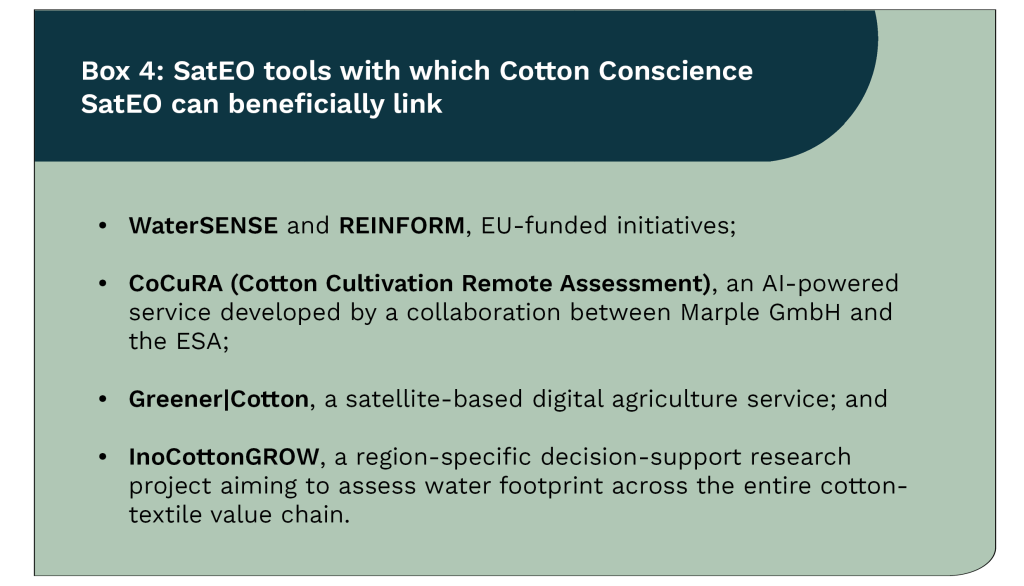
Cotton Conscience research will ultimately include geo-tagging, enabling identification and monitoring of cotton fields. It aims to verify farming practices including water use, irrigation type and pesticide applications, and the ability to trace cotton back to its origin, ensuring more responsible sourcing. This will ideally dovetail with wider geo-tagging approaches used in the cotton industry such as those listed in Box 5.
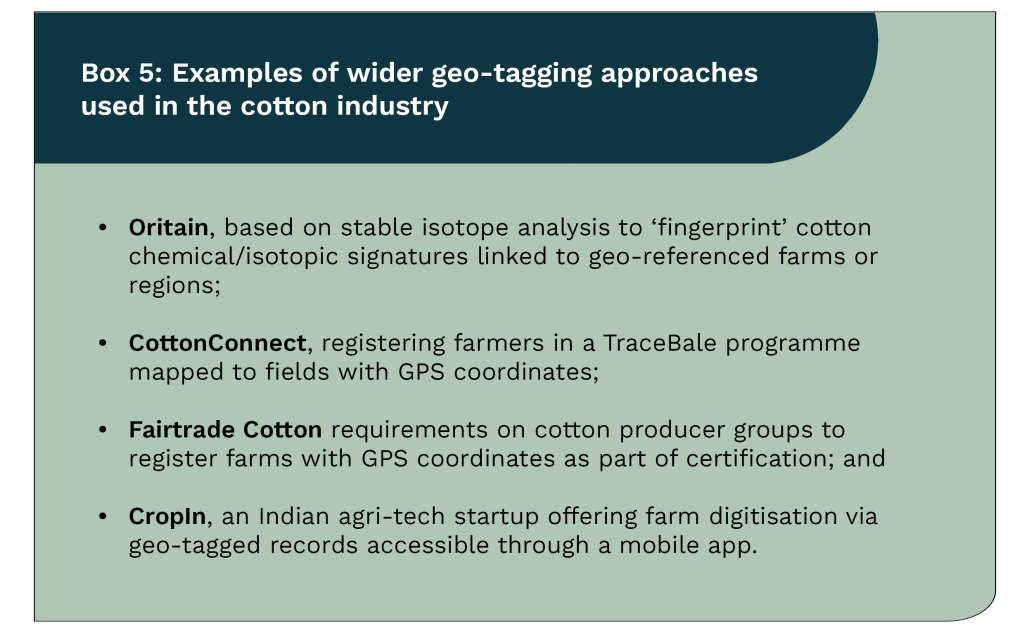
The third tool explored under the Cotton Conscience project is DNA tagging, assigning a unique and durable DNA identifier detectable in finished products even after heat and washing treatment and recycling.22 Given the costs and practicality, DNA tagging is only currently applied by some large producers or after the ginning stage; it may be less feasible for smaller and less affluent producers in developing nations.
Aims and limitations of Cotton Conscience
Cotton Conscience is an exploratory project seeking to integrate and demonstrate the values of SatEO, geotagging and DNA tagging technologies in order to make water use, from field through to mill, transparent and auditable. It responds to growing concern amongst brands, retailers and their customers about all aspects of the footprint of the cotton value chain, aiming to drive the practice and appreciation of the value of sustainable development.
FWR Analysis Articles are designed to provide a view on topical issues across the water sector. This is an opinion article and does not necessarily reflect the views of the FWR, IES or the author’s current or past affiliated organisations.
References
1 Radhakrishnan, S. (2017). Sustainable cotton production. In Sustainable fibres and textiles. Woodhead Publishing, Sawston, Cambridge.
2 Shirsath, P. (2024). Organic Cotton Fiber Market Report 2025 (Global Edition). Cognitive Market Research. https://www.cognitivemarketresearch.com/organic-cotton-fiber-market-report. (Accessed: 20 October 2025).
3 Fairtrade International. (2025). Cotton. Fairtrade International. https://www.fairtrade.net/product/cotton/ (Accessed: 20 October 2025).
4 Better Cotton Initiative. (2024). Better Cotton Traceability: Looking Back on a Year of Progress. Better Cotton Initiative. https://bettercotton.org/better-cotton-traceability-looking-back-on-a-year-of-progress/. (Accessed: 20 October 2025).
5 Better Cotton Initiative. (2025). Water Stewardship. Better Cotton Initiative. https://bettercotton.org/field-level-results-impact/key-sustainability-issues/water-stewardship/?utm_source=chatgpt.com. (Accessed: 16 October 2025).
6 USCTP. (2025). Environmental data tracking. US Cotton Trust Protocol (USCTP). https://trustuscotton.org/about/powered-by-data/. (Accessed: 20 October 2025).
7 World Wildlife Fund. (n.d.). Cleaner, greener cotton: Summary report. https://wwfint.awsassets.panda.org/downloads/cotton_for_printing_summary_report.pdf (Accessed: 15 October 2025).
8 Xuewei, Z. et al (2024). The Impact of Factor Price Change on China’s Cotton Production Pattern Evolution: Mediation and Spillover Effects. https://www.mdpi.com/2077-0472/14/7/1145. (Accessed: 19 November 2025).
9 Filipenco, D. (2025). From fields to fabric: the leading cotton producing countries around the world. Development Aid. https://www.developmentaid.org/news-stream/post/168472/top-cotton-producing-countries-in-the-world?utm. (Accessed: 20 October 2025).
10 Fortune Business Insights. (2025). Organic Cotton Market Size, Share & Industry Analysis, By Type (Long-Staple Cotton, Short-Staple Cotton, Middle Staple Cotton, Extra-long Staple Cotton, and Others), By Quality Type (Supima/Pima, Upland, Giza, and Others), By Application (Apparel, Packaging, and Others), and Regional Forecast, 2024-2032. Fortune Business Insights, 29 September 2025. https://www.fortunebusinessinsights.com/organic-cotton-market-106612. (Accessed: 20 October 2025).
11 Mikucioniene, D., Mínguez-García, D., Repon, M. R., et al. (2024). Understanding and addressing the water footprint in the textile sector: a review. AUTEX Research Journal, 24(1), 20240004. DOI: https://doi.org/10.1515/aut-2024-0004.
12 UNESCO. (2024). United Nations World Water Development Report 2024: Water for Prosperity and Peace. United Nations Educational, Scientific and Cultural Organization (UNESCO), Paris. https://www.un.org/sustainabledevelopment/blog/2024/03/un-world-water-development-report/. (Accessed: 15 October 2025).
13 Chapagain, A.K., Hoekstra, A.Y., Savenije, H.H.G. and Gautam, R. (2006). The water footprint of cotton consumption: An assessment of the impact of worldwide consumption of cotton products on the water resources in the cotton producing countries. Ecological Economics, 60(1), pp.186–203. DOI: https://doi.org/10.1016/j.ecolecon.2005.11.027.
14 Hoskins, T. (2014). Cotton production linked to images of the dried-up Aral Sea basin. The Guardian, 1 October 2014. https://www.theguardian.com/sustainable-business/sustainable-fashion-blog/2014/oct/01/cotton-production-linked-to-images-of-the-dried-up-aral-sea-basin (Accessed: 20 October 2025).
15 Transparentem. (2025). From Field to Fabric: Enhancing Due Diligence in Cotton Supply Chains: India. Transparentem. https://transparentem.org/wp-content/uploads/2025/01/From-Field-to-Fabric-Enhancing-Due-Diligence-in-Cotton-Supply-Chains.pdf. (Accessed: 20 October 2025).
16 EarthSight. (2024). Fashion Crimes. EarthSight. https://www.earthsight.org.uk/fashion-crimes. (Accessed: 20 October 2025).
17 Roberts, R. (2005). Insurance of crops in developing countries. FAO Agricultural Services Bulletin 159. https://www.fao.org/4/y5996e/y5996e00.htm. (Accessed: 20 October 2025).
18 Shabbir, A., Arshad, M., Bakhsh, A., Usman, M., Shakoor, A., Ahmad, I., & Ahmad, A. (2012). Apparent and real water productivity for cotton-wheat zone of Punjab, Pakistan. Pakistan. Journal of Agricultural Science, 49(3).
19 Textile Exchange. (2022). Organic Cotton Market Report 2022. Textile Exchange. https://textileexchange.org/app/uploads/2022/10/Textile-Exchange_OCMR_2022.pdf. (Accessed: 18 October 2025).
20 Çetin, Ö. (2021). Sustainable water saving and water productivity using different irrigation systems for cotton production. Presented at the 3rd World Irrigation Forum, ICID, Bali, Indonesia. https://www.icid.org/wif3_bali_2019/wif3_1-3_31-min.pdf. (Accessed: 18 October 2025).
21 IWMI. (2018). Water user associations; Learning to deliver on their promise in Africa. International Water Management Institute (IWMI). 13 June 208. https://www.iwmi.org/blogs/water-user-associations/. (Accessed: 20 October 2025).
22 James, A., Hayward, J. and Stalnaker, R. (2020). Molecular tagging of cotton: A forensic approach to supply chain transparency. Forensic Science International, 314, 110387. DOI: https://doi.org/10.1016/j.forsciint.2020.110387.
Featured Header Image: Cotton growing © Photography by Rob D | Adobe Stock

